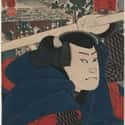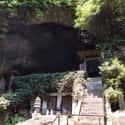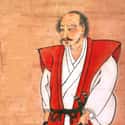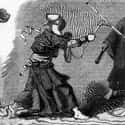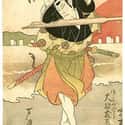(#14) He Left Home At A Young Age To Live With His Uncle, A Buddhist Monk
In 1584, Shinmen Musashi was born in Miyamoto village to a samurai family. His mother perished during childbirth, and his father, Shinmen Munisai, was an expert swordsman and served as Musashi's first teacher. Munisai was harsh and strict, especially toward his young son.
When Musashi was either nine or ten, he went to live with his uncle. Some accounts claim his father abandoned him, while others say he was killed in a duel. Some think Musashi simply ran away. In any case, Musashi took little else from his father but his name and the basic techniques of the samurai.
Musashi's uncle Dorin was a monk from the Shoreian temple in Miyamoto. At the temple, Musashi learned Zen Buddhism, reading, and writing. He continued to hone his swordsmanship until he left the temple to become a shugyosha (wandering samurai in training) at some point between the ages of 16 and 20.
(#13) He Wrote A Book Of Five Rings In A Mountain Cave Near A Zen Monastery
After suffering an attack of neuralgia, Musashi sensed his life was nearing its end. In 1643, he retired to Reigando, a mountian cave near Kumamoto (far to the south of Japan, near Nagasaki). The cave was part of a Zen monastery, where Musashi went to sit in contemplation and pen A Book of Five Rings, as well as the shorter Dokkodo (The Way of Walking Alone).
A Book of Five Rings is a treatise not only on swordsmanship but on strategy and philosophy. It can be thought of as an outline of the path to enlightenment by the way of strategy, as phrased by Musashi. The book is divided into five sections, reflecting five elements: earth, water, fire, wind, and void. The book intertwines practical advice with Zen philosophy and is still highly regarded in the 21st century.
In his book, Musashi wrote,
"When I reached thirty I looked back on my past. The previous victories were not due to my having mastered strategy. Perhaps it was natural ability, or the order of heaven, or that other schools' strategy was inferior. After that, I studied morning and evening searching for the principle, and came to realize the Way of strategy when I was fifty."
(#10) He Died With His Sword In Hand
At 61 or 62, after completing A Book of Five Rings, finishing the Dokkodo, and suffering from neuralgia – a painful nerve disorder – Musashi knew he was dying. He summoned the monks he was staying with in the monastery near Reigando, pulled himself up onto one knee and, holding his sword in one hand and cane in the other, died like a true samurai warrior.
Many believe his cause of death to be thoracic cancer. He was buried standing and dressed in full samurai body armor.
(#8) He Fought Against – And Defeated – Masters Of Every Weapon
Musashi didn't just fight swordsmen in duels; he purposefully sought out masters of every weapon. In 1607, he sought out an undefeated master of the kusarigama (sickle and chain) named Shishido Baiken. According to legend, Baiken struck first with the chain, dulling and bending Musashi's blade. As the two drew close to one another, Musashi pulled out his short sword, usually only used in ritual suicide. Baiken hesitated, providing Musashi with the opportunity to drive the short sword into Baiken. With his last breath Baiken whispered, "Thank you."
Later that same year, Musashi defeated Muso Gonnosuke who was a master of jojutsu (a short staff technique). At the time, Gonnosuke had allegedly never lost a duel. Since the two agreed to battle with wooden swords, Gonnosuke survived, despite his defeat. Gonnosuke spent years training for a rematch, only for Musashi to win again.
In A Book of Five Rings, Musashi wrote, "You should not have a favorite weapon. To become over-familiar with one weapon is as much a fault as not knowing it sufficiently well."
(#12) He Fought In The Epochal Battle Of Sekigahara
In October, 1600, Japan was at a crossroads. The man who had unified much of the island under one banner, Toyotomi Hideyoshi, perished in 1598. The resulting struggle for succession was decided in a battle in the valley of Sekigahara between Ishida Mitsunari and his forces – claiming to represent the interests of Hideyoshi's young son, Hideyori – and noted general and former ally of Hideyoshi, Tokugawa Ieyasu.
Despite being outnumbered 80,000 to 74,000, Tokugawa's forces won the day when one of Ishida's allies defected. Ishida was driven into the mountains and slaughtred several days later. The decisive victory marked the end of the Sekigahara period and the beginning of the Tokugawa Shogunate.
Musashi was one of many shugyosha who fought in order to make a name for himself. Unfortunately, he fought for the side of Ishida. He did, however, survive, and he went on to fight more battles and duels. While he didn't gain renown in battle, he did gain valuable experience that would help him become Japan's greatest swordsman.
(#3) He Defeated A Master Swordsman With A Wooden Sword Carved From An Oar
In Musashi's most famous duel, he faced off against Sasaki Kojiro, also known as the Demon of the West. Kojiro was the ideal samurai in many ways: he was highly respected and classically trained in the Chujō-ryū school, and he was the creator and head of the Ganryū school of sword fighting. Kojiro used the longer-than-usual no-dachi two-handed sword in his technique to give himself superior range.
The duel was set for the morning of April 13, 1612, on the island of Funashima (now called Ganryū after Kojiro's famous fighting style). When the time came, however, Musashi was nowhere to be found. Kojiro and the officials sent to observe the fight were left waiting for hours. When Musashi finally arrived, intentionally late, he was disheveled and holding a bokken (a wooden sword) he had fashioned from an oar he found on the boat ride to the duel. Making opponents wait was a psychological tactic integral to Musashi's battle strategy.
Kojiro was furious about this display of disrespect. He is said to have cast aside his sheath in anger, to which Musashi responded, "If you have no more use for your sheath, you are already dead." Musashi had carved his bokken to be several inches longer than Kojiro's no-dachi, negating Kojiro's primary advantage and enabling Musashi's victory.
New Random Displays Display All By Ranking
About This Tool
The identity of a Japanese samurai is a hereditary heritage, not a profession. Some samurais are also very prestigious scholars, and they can also serve as civil and military administrators, clergy, painters, and aestheticians. There were many famous samurai in history, the greatest should be Musashi Miyamoto. He was a famous swordsman at the end of the Sengoku period in Japan and became famous for his superb swordsmanship and achievements.
Miyamoto Musashi lived in a turbulent historical period, but he devoted himself to the study of warfare and swordsmanship and made great achievements. The random tool shares 14 facts about the violent life of this greatest samurai.
Our data comes from Ranker, If you want to participate in the ranking of items displayed on this page, please click here.











